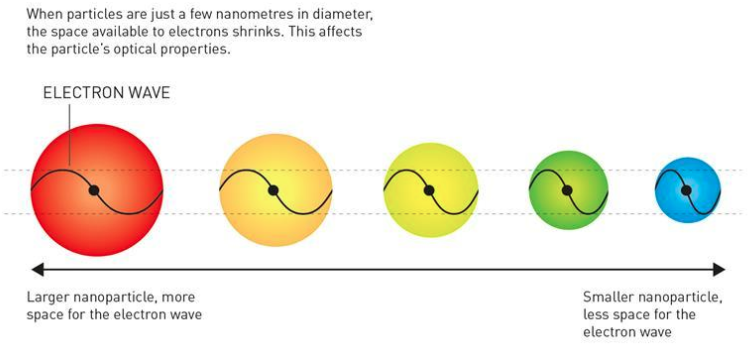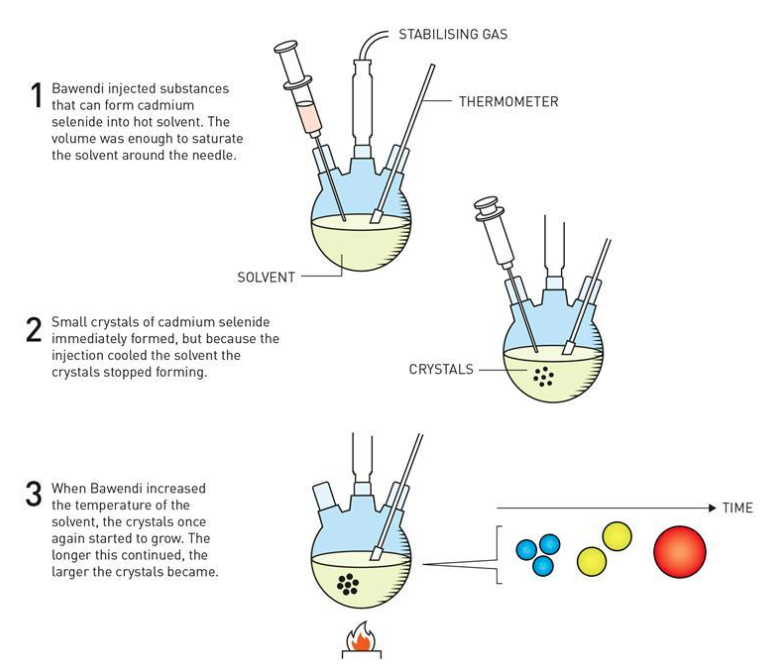
I used to stubbornly believe that compounds with identical chemical compositions would exhibit identical properties. That conviction was shattered by the 2023 Nobel Prize in Chemistry, awarded for the discovery and synthesis of quantum dots. When matter shrinks to the scale of quantum dots, certain quantum effects emerge, meaning their properties depend not only on their elemental composition, but also crucially on their size.

Quantum dots have added a new dimension to the periodic table: size.
This core concept reveals that the same substance, merely by changing its size, can exhibit radically different properties. Identical material, different sizes – emitting light of different colors, possessing fundamentally distinct characteristics.
What Exactly Are Quantum Dots?
Simply put, quantum dots are clusters of atoms and molecules at the nanoscale. Comprising just a few hundred to a few thousand atoms, their size ranges from 2 to 10 nanometers. When they absorb light, they fluoresce, emitting light of different colors depending on their size.

Why Does Size Matter?
A material's optical properties are governed by its electrons. When electrons absorb photons, they jump to higher energy states. Therefore, a shift in the wavelength of absorbed light signifies corresponding changes in other electron-controlled properties, such as catalytic activity and electrical conductivity. In essence, altering only the size transforms a quantum dot into a fundamentally new material with distinct properties. If you can change a material's color through size control, you've effectively created a novel material.
What Can Quantum Dots Do?
Their most prominent application today is undoubtedly in display technology. Quantum dots exhibit narrow emission spectra, enabling exceptionally vibrant and pure colors. They also emit light with minimal energy loss, significantly extending display lifespan. Beyond displays, they serve as fluorescent probes for precise surgical guidance and targeted drug delivery, enhance photoelectric conversion efficiency in solar cells, act as catalysts to drive chemical reactions, and hold potential for quantum computing and secure quantum communication.
Within these tiny specks lies immense scientific allure. Quantum dots have unveiled the secret behind material color transformation and opened a gateway to the vast world of nanomaterials.
Primary synthesis methods include physical, chemical, and biological approaches, with chemical synthesis being dominant. Bawendi's Nobel-recognized work utilized a chemical method: "hot injection" in a high-boiling-point, non-polar organic solvent (which also acts as a ligand). This produces colloidal quantum dots with high crystallinity, uniform size distribution, and tunable sizes over a broad range.

However, the initial precursor, dimethylcadmium (Cd(CH₃)₂), was highly toxic, explosive, expensive, and required harsh reaction conditions.
Today, quantum dot materials are commercially applied, and green synthesis is a major research focus. Currently, the most promising approach is the "non-injection" method. This uses precursors like II-VI group elements (e.g., CdS, CdSe, CdTe, ZnSe) or III-V group elements (e.g., InP, InAs), synthesized in a system of 1-octadecene (ODE, a non-coordinating solvent) and oleic acid (OA, a ligand). 1-Octadecene, with its low melting point and low cost, is now a mainstream solvent for quantum dot synthesis.